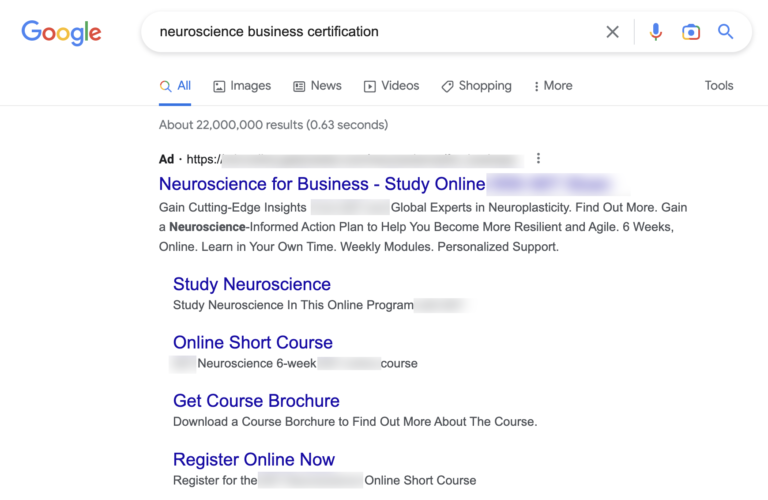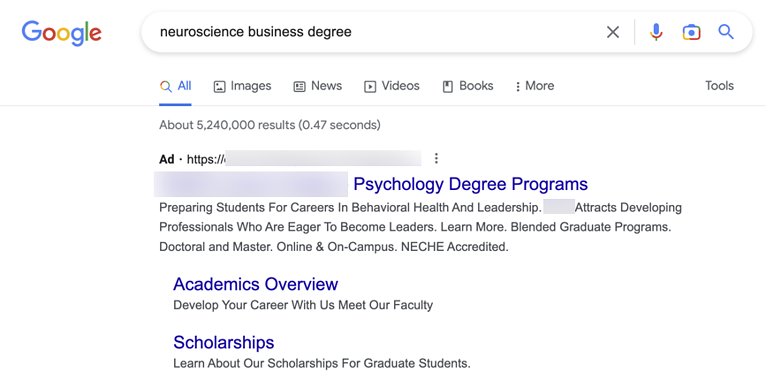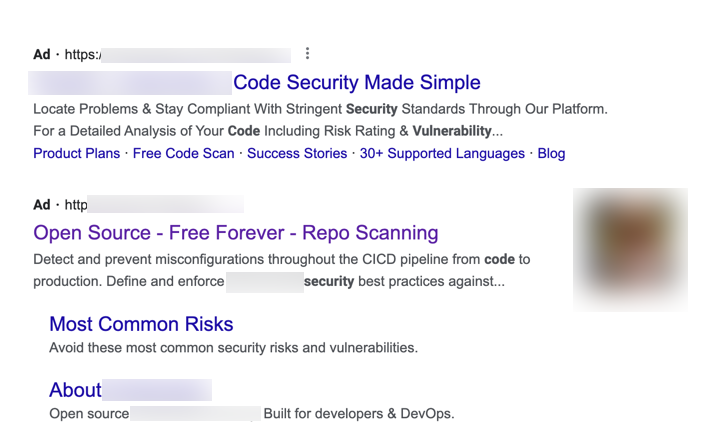SEO
Everything You Need To Know

Of all the many, many functions available in Google Ads, I have a few that are my favorites. And sitelink assets – previously known as sitelink extensions – are at the top of my list.
Why? Because they’re so versatile. You can do almost anything with them if you think through your strategy carefully.
For example, you can use the mighty sitelink in your advertising to:
- Promote low search volume themes.
- Push lagging products out the door.
- Maximize hot sellers.
- Highlight certain product categories.
- Answer common questions.
- Handle PR problems.
And that’s just a start! Sitelink assets can almost do it all.
Best Practices For Using Sitelink Assets Extensions
If you truly want to get the most out of your sitelinks, you need to think about your intention.
To help you with that, I’m going to lay out a few sitelink guidelines.
1. Get clear on your objectives. Before you start, you need to think about your goals. What are you trying to achieve with these assets? Are you advertising products or services? Will the asset work well with both branded and non-branded keywords? Your answers to these questions will help determine if your sitelinks are versatile and useful to the searcher.
2. Use sitelinks as part of your larger strategy. Don’t think of your sitelinks in isolation. You should also consider the accompanying ad, landing page, and other assets. Make sure they all work together in service to your overarching strategy.
3. Use a mix of sitelinks. Sitelinks can serve multiple purposes, so make sure you’re using a variety. For example, you don’t want to use every sitelink on an ad to promote on-sale products. Instead, use a mix. One could promote an on-sale product, one could generate leads, one could highlight a new product category, and one could direct prospective clients to useful information.
4. Create landing pages for your sitelinks. Ideally, you want to send users to landing pages that tightly correlate with your sitelink instead of just a regular page on your website.
5. Track sitelink performance and adjust. It’s not enough to set up sitelinks. You should also track them to see which links are getting traction and which ones are not. This doesn’t mean that all sitelinks should perform equally (more on this below), but it does mean they should perform well given their type and objectives.
Why it’s Better To Use A Mix Of Sitelink Assets
Let’s dive deeper into this idea of using a mix of sitelinks by looking at an example.
In a new client account, we created four different types of sitelinks:
- Two sitelinks are product-focused (as requested by the client).
- One sitelink connects users with an engineer to learn more about the product (“Speak to an Engineer”). It has more of a sales focus.
- One sitelink allows users to learn more about the products without speaking to an engineer (“What is?”).
The “What is?” sitelink is outperforming the “Speak to an Engineer” sitelink when we measure by CTR. While we need more data before making any changes, I predict we’ll eventually swap out the sales-y “Speak to an Engineer” sitelink for something else.
The fact that the educational link (“What is?”) is performing better than the sales-y link (“Speak to an Engineer”) isn’t too surprising in this case. The product is a new, cutting-edge robot that not many people are aware of, yet. They want more info before talking to someone.
By using a mix of sitelinks, and assessing the performance of each, we gained a lot of valuable information that is helping to guide our strategy for this account. So going with a mix of sitelinks is always a good idea. You never know what you’ll discover!
Sitelink Assets Examples
Now, let’s look at some specific examples of sitelink assets in Google Ads.
Example 1: Chromatography
 Screenshot from Google, January 2023
Screenshot from Google, January 2023Application Search: This ad is for a highly technical product that can be used in a wide variety of applications. (Chromatography is a laboratory technique for separating mixtures.) So putting “application search” in a sitelink here might make sense. It helps prospective clients find what they’re looking for.
Sign up and Save Big: A good sitelink for lead generation and potential revenue.
Technical Support: I’m not a big fan of putting technical support in sitelinks. Tech support seems more targeted to current users rather than prospective users. But who knows, maybe they really do want to help current users get tech support via their advertising.
Guides and Posters: Again, this sitelink is a bit unusual, but it might be appropriate for this product. Perhaps people are downloading branded posters and posting them in their workplaces. If so, it’s a great way to build brand awareness.
Example 2: Neuroscience Courses
 Screenshot from Google, January 2023
Screenshot from Google, January 2023I love everything about these sitelinks! The advertising is using them to reach people in all phases of the buyer journey.
For people not ready to commit:
- Study Neuroscience: This sitelink is broad and informational. It’s helpful to people who have just started to explore their options for studying neuroscience.
- Get Course Brochure: This sitelink is also great for people in the research phase. And while we mostly live in an online world, some people still prefer to consume hard-copy books, brochures, etc. With this sitelink, the school is covering its bases.
For people getting close to committing:
- Online Short Course: This is the course the school offers. It’s a great sitelink for those almost ready to sign up.
For people ready to sign up:
- Register Online Now: This is the strongest call to action for those ready to commit. It takes people directly to the signup page.
Example 3: Neuroscience Degrees
Let’s look at another example from the world of neuroscience education: this time for a neuroscience degree program.
 Screenshot from Google, January 2023
Screenshot from Google, January 2023In contrast to the previous two examples, the sitelinks in this ad aren’t as strong.
Academics Overview: This sitelink seems more appropriate for a broad term search, such as a search on the school’s name. If the searcher is looking for a specific degree program (which seems like the intention based on the term and the ad), the sitelinks should be something specific to that particular degree program.
Scholarships: Just as with the above sitelink, “Scholarships” doesn’t seem very helpful either. The topic of scholarships is important—but probably doesn’t need to be addressed until the person determines that this school is a good fit.
Example 4: Code Security
Next, let’s look at two Google search ads for code security products.
 Screenshot from Google, January 2023
Screenshot from Google, January 2023
The sitelinks in these two ads look like typical assets you’d find for SaaS, cloud-based, or tech companies. They click through to a lot of helpful information, such as product plans and success stories.
I particularly like the Most Common Risks sitelink in the second ad. It leads to a helpful article that would be great for engaging top-of-funnel leads.
On the flip side, I’m not a big fan of the Blog sitelink in the first ad. “Blog” simply isn’t very descriptive or helpful.
Still, there are no right or wrong sitelinks here. And it would be interesting to test my theory that blog content is not a top-performing asset!
Sitelink Assets Are More Than An Afterthought
I hope I’ve convinced you of the usefulness and versatility of sitelinks when created with specific objectives that align with your broader strategy.
So don’t create your sitelink assets as an afterthought.
Because if you give them the careful consideration they deserve, they’ll serve you well.
Note: Google sitelink assets were previously known as sitelink extensions and renamed in September 2022.
More resources:
Featured Image: Thaspol Sangsee/Shutterstock
SEO
brightonSEO Live Blog

Hello everyone. It’s April again, so I’m back in Brighton for another two days of Being the introvert I am, my idea of fun isn’t hanging around our booth all day explaining we’ve run out of t-shirts (seriously, you need to be fast if you want swag!). So I decided to do something useful and live-blog the event instead.
Follow below for talk takeaways and (very) mildly humorous commentary. sun, sea, and SEO!
SEO
Google Further Postpones Third-Party Cookie Deprecation In Chrome

Google has again delayed its plan to phase out third-party cookies in the Chrome web browser. The latest postponement comes after ongoing challenges in reconciling feedback from industry stakeholders and regulators.
The announcement was made in Google and the UK’s Competition and Markets Authority (CMA) joint quarterly report on the Privacy Sandbox initiative, scheduled for release on April 26.
Chrome’s Third-Party Cookie Phaseout Pushed To 2025
Google states it “will not complete third-party cookie deprecation during the second half of Q4” this year as planned.
Instead, the tech giant aims to begin deprecating third-party cookies in Chrome “starting early next year,” assuming an agreement can be reached with the CMA and the UK’s Information Commissioner’s Office (ICO).
The statement reads:
“We recognize that there are ongoing challenges related to reconciling divergent feedback from the industry, regulators and developers, and will continue to engage closely with the entire ecosystem. It’s also critical that the CMA has sufficient time to review all evidence, including results from industry tests, which the CMA has asked market participants to provide by the end of June.”
Continued Engagement With Regulators
Google reiterated its commitment to “engaging closely with the CMA and ICO” throughout the process and hopes to conclude discussions this year.
This marks the third delay to Google’s plan to deprecate third-party cookies, initially aiming for a Q3 2023 phaseout before pushing it back to late 2024.
The postponements reflect the challenges in transitioning away from cross-site user tracking while balancing privacy and advertiser interests.
Transition Period & Impact
In January, Chrome began restricting third-party cookie access for 1% of users globally. This percentage was expected to gradually increase until 100% of users were covered by Q3 2024.
However, the latest delay gives websites and services more time to migrate away from third-party cookie dependencies through Google’s limited “deprecation trials” program.
The trials offer temporary cookie access extensions until December 27, 2024, for non-advertising use cases that can demonstrate direct user impact and functional breakage.
While easing the transition, the trials have strict eligibility rules. Advertising-related services are ineligible, and origins matching known ad-related domains are rejected.
Google states the program aims to address functional issues rather than relieve general data collection inconveniences.
Publisher & Advertiser Implications
The repeated delays highlight the potential disruption for digital publishers and advertisers relying on third-party cookie tracking.
Industry groups have raised concerns that restricting cross-site tracking could push websites toward more opaque privacy-invasive practices.
However, privacy advocates view the phaseout as crucial in preventing covert user profiling across the web.
With the latest postponement, all parties have more time to prepare for the eventual loss of third-party cookies and adopt Google’s proposed Privacy Sandbox APIs as replacements.
Featured Image: Novikov Aleksey/Shutterstock
SEO
How To Write ChatGPT Prompts To Get The Best Results

ChatGPT is a game changer in the field of SEO. This powerful language model can generate human-like content, making it an invaluable tool for SEO professionals.
However, the prompts you provide largely determine the quality of the output.
To unlock the full potential of ChatGPT and create content that resonates with your audience and search engines, writing effective prompts is crucial.
In this comprehensive guide, we’ll explore the art of writing prompts for ChatGPT, covering everything from basic techniques to advanced strategies for layering prompts and generating high-quality, SEO-friendly content.
Writing Prompts For ChatGPT
What Is A ChatGPT Prompt?
A ChatGPT prompt is an instruction or discussion topic a user provides for the ChatGPT AI model to respond to.
The prompt can be a question, statement, or any other stimulus to spark creativity, reflection, or engagement.
Users can use the prompt to generate ideas, share their thoughts, or start a conversation.
ChatGPT prompts are designed to be open-ended and can be customized based on the user’s preferences and interests.
How To Write Prompts For ChatGPT
Start by giving ChatGPT a writing prompt, such as, “Write a short story about a person who discovers they have a superpower.”
ChatGPT will then generate a response based on your prompt. Depending on the prompt’s complexity and the level of detail you requested, the answer may be a few sentences or several paragraphs long.
Use the ChatGPT-generated response as a starting point for your writing. You can take the ideas and concepts presented in the answer and expand upon them, adding your own unique spin to the story.
If you want to generate additional ideas, try asking ChatGPT follow-up questions related to your original prompt.
For example, you could ask, “What challenges might the person face in exploring their newfound superpower?” Or, “How might the person’s relationships with others be affected by their superpower?”
Remember that ChatGPT’s answers are generated by artificial intelligence and may not always be perfect or exactly what you want.
However, they can still be a great source of inspiration and help you start writing.
Must-Have GPTs Assistant
I recommend installing the WebBrowser Assistant created by the OpenAI Team. This tool allows you to add relevant Bing results to your ChatGPT prompts.
This assistant adds the first web results to your ChatGPT prompts for more accurate and up-to-date conversations.
It is very easy to install in only two clicks. (Click on Start Chat.)
For example, if I ask, “Who is Vincent Terrasi?,” ChatGPT has no answer.
With WebBrower Assistant, the assistant creates a new prompt with the first Bing results, and now ChatGPT knows who Vincent Terrasi is.
 Screenshot from ChatGPT, March 2023
Screenshot from ChatGPT, March 2023You can test other GPT assistants available in the GPTs search engine if you want to use Google results.
Master Reverse Prompt Engineering
ChatGPT can be an excellent tool for reverse engineering prompts because it generates natural and engaging responses to any given input.
By analyzing the prompts generated by ChatGPT, it is possible to gain insight into the model’s underlying thought processes and decision-making strategies.
One key benefit of using ChatGPT to reverse engineer prompts is that the model is highly transparent in its decision-making.
This means that the reasoning and logic behind each response can be traced, making it easier to understand how the model arrives at its conclusions.
Once you’ve done this a few times for different types of content, you’ll gain insight into crafting more effective prompts.
Prepare Your ChatGPT For Generating Prompts
First, activate the reverse prompt engineering.
- Type the following prompt: “Enable Reverse Prompt Engineering? By Reverse Prompt Engineering I mean creating a prompt from a given text.”
 Screenshot from ChatGPT, March 2023
Screenshot from ChatGPT, March 2023ChatGPT is now ready to generate your prompt. You can test the product description in a new chatbot session and evaluate the generated prompt.
- Type: “Create a very technical reverse prompt engineering template for a product description about iPhone 11.”
 Screenshot from ChatGPT, March 2023
Screenshot from ChatGPT, March 2023The result is amazing. You can test with a full text that you want to reproduce. Here is an example of a prompt for selling a Kindle on Amazon.
- Type: “Reverse Prompt engineer the following {product), capture the writing style and the length of the text :
product =”
 Screenshot from ChatGPT, March 2023
Screenshot from ChatGPT, March 2023I tested it on an SEJ blog post. Enjoy the analysis – it is excellent.
- Type: “Reverse Prompt engineer the following {text}, capture the tone and writing style of the {text} to include in the prompt :
text = all text coming from https://www.searchenginejournal.com/google-bard-training-data/478941/”
 Screenshot from ChatGPT, March 2023
Screenshot from ChatGPT, March 2023But be careful not to use ChatGPT to generate your texts. It is just a personal assistant.
Go Deeper
Prompts and examples for SEO:
- Keyword research and content ideas prompt: “Provide a list of 20 long-tail keyword ideas related to ‘local SEO strategies’ along with brief content topic descriptions for each keyword.”
- Optimizing content for featured snippets prompt: “Write a 40-50 word paragraph optimized for the query ‘what is the featured snippet in Google search’ that could potentially earn the featured snippet.”
- Creating meta descriptions prompt: “Draft a compelling meta description for the following blog post title: ’10 Technical SEO Factors You Can’t Ignore in 2024′.”
Important Considerations:
- Always Fact-Check: While ChatGPT can be a helpful tool, it’s crucial to remember that it may generate inaccurate or fabricated information. Always verify any facts, statistics, or quotes generated by ChatGPT before incorporating them into your content.
- Maintain Control and Creativity: Use ChatGPT as a tool to assist your writing, not replace it. Don’t rely on it to do your thinking or create content from scratch. Your unique perspective and creativity are essential for producing high-quality, engaging content.
- Iteration is Key: Refine and revise the outputs generated by ChatGPT to ensure they align with your voice, style, and intended message.
Additional Prompts for Rewording and SEO:
– Rewrite this sentence to be more concise and impactful.
– Suggest alternative phrasing for this section to improve clarity.
– Identify opportunities to incorporate relevant internal and external links.
– Analyze the keyword density and suggest improvements for better SEO.
Remember, while ChatGPT can be a valuable tool, it’s essential to use it responsibly and maintain control over your content creation process.
Experiment And Refine Your Prompting Techniques
Writing effective prompts for ChatGPT is an essential skill for any SEO professional who wants to harness the power of AI-generated content.
Hopefully, the insights and examples shared in this article can inspire you and help guide you to crafting stronger prompts that yield high-quality content.
Remember to experiment with layering prompts, iterating on the output, and continually refining your prompting techniques.
This will help you stay ahead of the curve in the ever-changing world of SEO.
More resources:
Featured Image: Tapati Rinchumrus/Shutterstock
-

 PPC6 days ago
PPC6 days ago19 Best SEO Tools in 2024 (For Every Use Case)
-

 MARKETING7 days ago
MARKETING7 days agoEcommerce evolution: Blurring the lines between B2B and B2C
-
SEARCHENGINES5 days ago
Daily Search Forum Recap: April 19, 2024
-
SEARCHENGINES6 days ago
Daily Search Forum Recap: April 18, 2024
-

 WORDPRESS6 days ago
WORDPRESS6 days agoHow to Make $5000 of Passive Income Every Month in WordPress
-

 SEO7 days ago
SEO7 days ago2024 WordPress Vulnerability Report Shows Errors Sites Keep Making
-

 WORDPRESS7 days ago
WORDPRESS7 days ago10 Amazing WordPress Design Resouces – WordPress.com News
-

 SEO6 days ago
SEO6 days ago25 WordPress Alternatives Best For SEO
















You must be logged in to post a comment Login